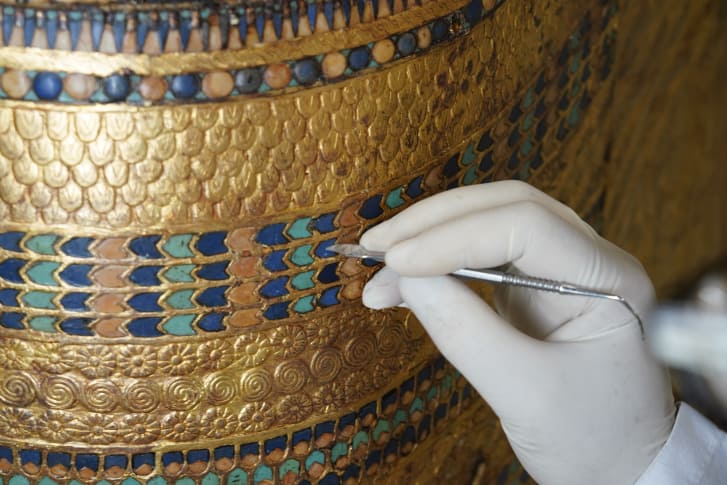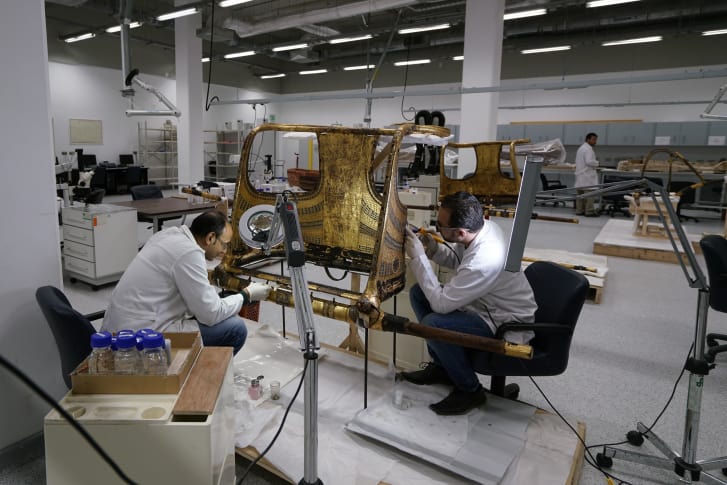
At the edge of the ancient pyramids of Giza, some 5,000 construction workers labor around the clock to finish the long-awaited Grand Egyptian Museum.
Expected to open by the end of this year, the 5.2-million-square-foot structure will become the world’s largest museum devoted to a single civilization.
“This will be the museum of the 21st century,” said its director general, Tarek Tawfik.
“All means of modern technology have been taken into consideration in order to make this an unforgettable experience for the visitor, but at the same time provide the best possible environment for the artifacts.”
Costing more than $1 billion, the museum will re-house and restore some of the country’s most precious relics. Its expansive, glass-fronted building offers sweeping panoramas of the Giza plateau and Great Pyramids, which stand just two kilometers away.
“To have a building that harmonizes well with these pyramids and provides, for the next generation of young Egyptians, a place where they can really get to know the roots of the civilization of their history — this is something fantastic,” Tawfik said.
A conservation operation
When Mohamed Yousri, a conservationist, received Tutankhamun’s sandals, he was told the artifact would be impossible to restore. The pharaonic footwear, which dates back more than 3,500 years, was tattered. The soles had disintegrated and the once-intricate beading long destroyed — a priceless treasure seemingly lost forever. But Yousri refused to give up.
“We created a new technique by using a special adhesive,” Yousri said, presenting the now magnificent sandals. “(The condition) was very bad, and here I think it has come alive again.”

A conservator works on a statue of Amun-Ra in the heavy stone room at the Grand Egyptian Museum conservation center.Credit: Dana Smillie
The artifact joins tens of thousands of others in the museum’s collection. Many have been revitalized by an army of conservationists and archaeologists, a long overdue operation for a country with thousands of years’ of civilization to preserve.
Some of the items might have been lost forever were it not for the Grand Egyptian Museum’s specialized labs, which now make up one of the largest conservation centers in the world.
The facilities offer a new home to relics previously held by the notoriously crowded Egyptian Museum, in central Cairo’s Tahrir square, once considered the country’s leading history institution.
“The museum at Tahrir is now 117 years old,” Tawfik said. “It has become an artifact and heritage building itself. (In) its time, it was a great museum, but through the decades, it became more and more a store room.
“At the Grand Egyptian Museum the artifacts really have enough space to be shown in their full splendor.”
Recovering lost tourism
The new museum’s first test — its soft opening — is scheduled for the end of this year, when a collection of Tutankhamun’s possessions will go on display in approximately one-third of the museum space.
The facility’s 17 labs are helping to prepare the boy king’s 50,000 artifacts. King Tut’s bed is being re-made by wood specialists, his jewelry is being strung back to life in the organics lab and the grand obelisks of his era are receiving facelifts in the heavy stones room.
Using new technology and conservation techniques, every item in the collection is being re-examined. As a result, new discoveries have been among the dilapidated displays of previous museums.

Conservators work on the restoration of a chariot from Tutankhamun’s tomb at the Wood Laboratory in the Grand Egyptian Museum’s conservation center. Credit: Dana Smillie
“My colleague … found that this tunic was, for 80 years, displayed on the wrong side,” said conservationist Eman Shalaby, pointing to an ancient garment in a glass case. “This is actually the back of the tunic, not the front.”
Egypt has faced years of instability since the 2011 Arab Spring, which sparked the overthrow of then-President Hosni Mubarak and severely delayed construction of the Grand Egyptian Museum. Tourism, which once contributed more than 11% of the country’s GDP, was hit hard and has been slow to recover.
“Egyptians have always really held onto this project, knowing deep inside that this is something very important for them to provide a modern, safe environment for this priceless heritage,” said Tawfiq.
“Many people will be directly and indirectly benefiting from this project so, all in all, (it) will have an impact on Egypt and the tourism industry.”




